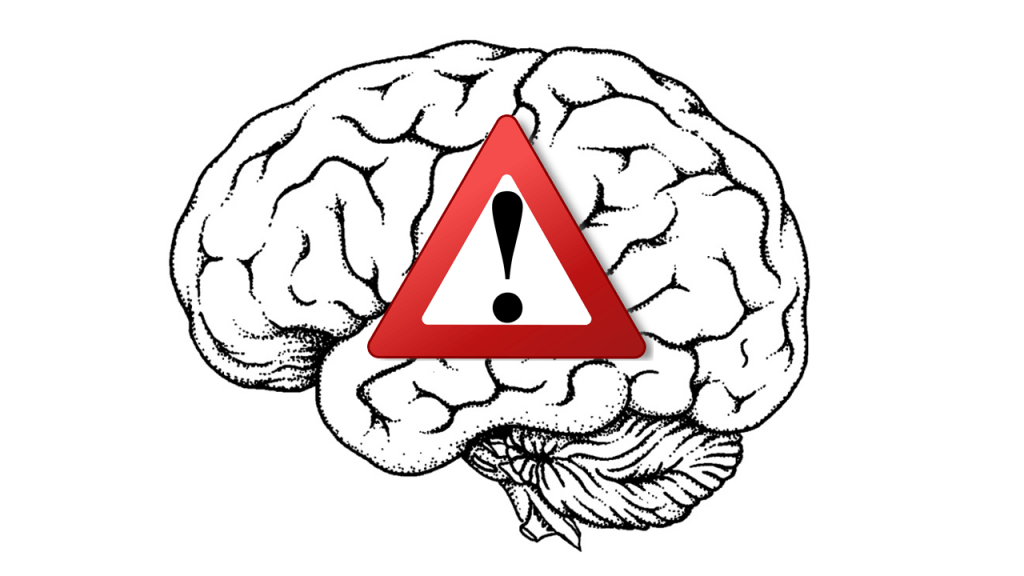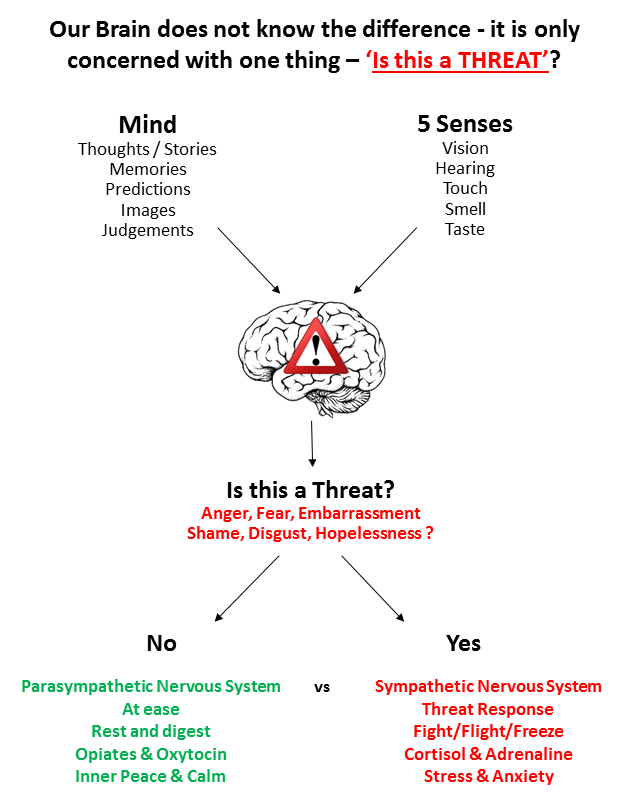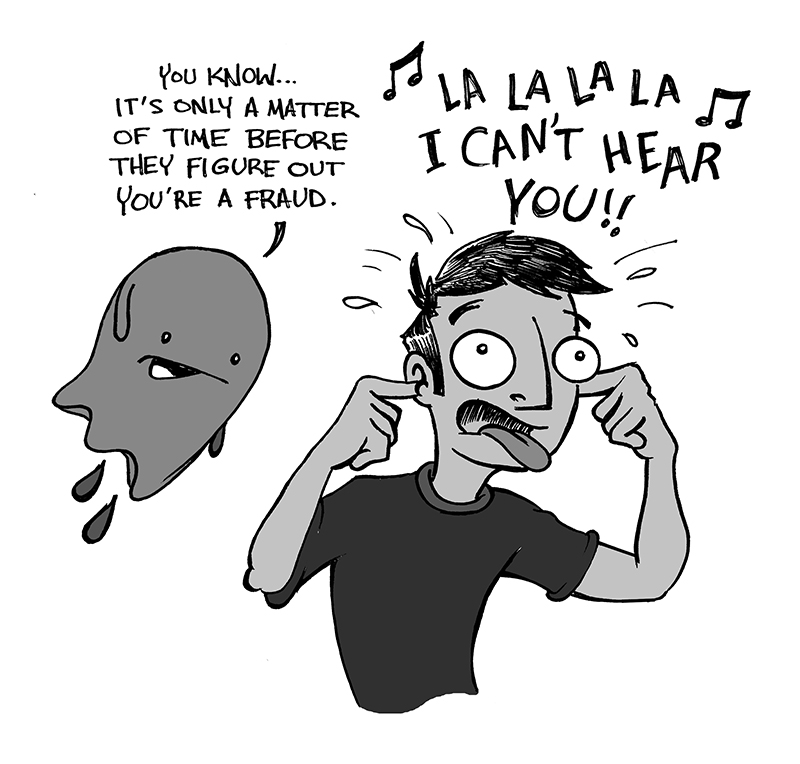
Overview
The brain is the body’s most complex organ. It balances physiological and psychological needs while responding to the environment – all at the same time! But, when it perceives something as a potential threat, it triggers a cascade of neurophysiological activity that re-organises its resources and attention so that it can focus on keeping the organism (read: ‘YOU!’) safe. When it is appropriate, this is very useful – because in turn ensures the survival of the organism. When it is not appropriate, the threat system can overwhelm us and can lead us to feeling Fearful, Angry, or Anxious. On the other hand, we may engage in self-criticism, or we may engage in avoidant or destructive patterns that make the situation worse for ourselves and others.
Although it is understandable that we would want to act to reduce and/or to protect ourselves from threats, when we let our threat systems dominate we are likely to act in ways that are disproportionate to the situation and this process will (often rapidly) get in our way. This typically happens when threat (or our sense of threat) is being created by our own perception and this is either happening without us knowing (due to undeveloped awareness) or is not being adequately addressed (due to a lack of understanding about the nature of the mind-body feedback loop, or low skill level in terms of ‘what’ to do about it).
This page discusses the biological aspects behind what the threat system is, and provides an evolutionary explanations as to why it works the way it does, in the hope that you will come to understand: a) That it is not our fault that we have a threat system – it is how the human brain has evolved for survival; and, b) Why it is important to learn skills to soothe our threat systems – from a biological and psychological perspective. Armed with a better understanding about ‘what’ our threat system is and what it is doing to our mind and body (and what you can do about it), with some skill-practice you will have more choice regarding how you respond to difficult situations that involve threat!
Understanding the Threat System: The Amygdala
One of the most important parts of the brain in terms of the threat system is the Amygdala. The amygdala is shaped like a little almond and lies deep in the brainstem in the limbic system, which consists of the hippocampus (responsible for memory), and the hypothalamus (which secretes hormones that regulate important bodily functions including the fight-flight response). The primary role of the Amygdalae (we actually have a pair of amygdala) lies with the processing of information in order determine whether or it needs to signal onwards to the limbic system that the brain needs to take action and do something.
All information that we experience from our 5 senses (taste, touch, vision, smell, and hearing) passes through our Amygdala which sorts this information into either ‘threat’ or a ‘non-threat’. For instance, if we are crossing the street with our head buried in our phone and you hear a ‘honking’ of a horn and the screeching of car tyres and with our peripheral vision we notice a huge dark car-shaped object heading our way, rapidly increasing in size as it gets closer, our Amygdala will likely sense of this visual information as “threat!” and it will stimulate our hypothalamus to trigger a ‘fight-flight response’.
The Fight-Flight Response (aka ‘fight-flight-freeze-appease’ or ‘fight-flight-flop-n-drop’ response): We have ancient protective circuits that can create a cascade of physiological activation designed to help us survive. In the context of the example above (being ‘honked’ at while distracted by our phones when crossing the road), the “flight” part of this response will increase our heart rate while slowing down digestion (so blood can be pumped FAST to our larger limbs so we can protect ourselves or escape), it will dilate our pupils (to let more light in so we can see better), and it will create a surge of adrenaline (which will give the body an instant burst of strength) so that we can drop that phone and jump out of the way of the speeding vehicle to survive!
However – and this is both a blessing and a downside of the threat system – the threat system also receives information from the Mind. This is where psychological problems emerge, because the mind can trigger a threat in the absence of a threat! Thankfully, when we come to understand and learn about our mind – we can learn to differentiate between these two sources of information: the information from our ‘mind’ vs the information from our ‘our 5 senses’. From this point (with skills training and some practice), we can learn to direct our minds in ways that can calm and soothe the threat system. The diagram below shows the two sources of information that can trigger our threat systems…
Sources of Threat (The Mind vs Our 5 Senses)
- Information from our mind is not real – it is a construction that can trigger a cascade of neural and emotional circuitry: This includes: Thoughts, Images, Memories Predictions, Judgments / Evaluations, Daydreaming, Self-Talk, Self-Criticism, and ‘Stories’ that we tell ourselves (e.g., the ‘I’m not good enough‘ story).
- Mental events are representations. They are NOT real; mental experiences are simply constructions of reality. If we imagine yummy food, we may salivate. If we think of something threatening, we may trigger anxiety and our threat system (e.g., remembering something that made us angry or fearful years ago can trigger our threat system which can make us feel as though it just happened or “it’s happening again…!” and similarly, imagining or predicting something threatening in the future can trigger the threat system by flooding the amygdala with threat-based imagery that can produce Fear or Anxiety)
In contrast,
- Information we receive from our 5 senses is real: Sight, Hearing, Taste, Touch, and Smell. These are actually happening (e.g., a bus heading for us as we cross the road without looking, is REAL). However, we can confuse ‘how real’ this information is with our minds – e.g. if we have a stomach ache, we feel this with our 5 senses (touch) we may have the thought “oh no – maybe I have cancer!” (The mind). Individuals who fear panic attacks (i.e., people who meet the criteria for a ‘Panic Disorder’) experience sensations in their bodies (aka ‘interoception’) as a cue for ‘danger’ and then experience a flood of anxiety in response to this interpretation. In other words, physical experiences can become ‘associated’ (in our mind) with the idea that “the body is in danger!”. This is not a fact – it is merely an interpretation (just like assuming that a pain in the stomach means you have stomach cancer). However, because our Brain does not know the difference between reality and what our mind’s are focusing on, this process can trigger our Threat System which only raises anxiety further (because it ‘would’ be terrible if we were in danger!). Because our Threat System operates on the ‘Better Safe Than Sorry Principle’, it can make us become hyper-fixated on further cues from our bodies to support the false association. Sadly, this can set the stage for a flooding of anxiety that can lead to (yet another) panic attack, which inadvertently ‘strengthens’ the association between “unpleasant sensations in our body” and “Threat”. If interested, you can read more about panic here.
Why is Making this Distinction Important?
Aside from brief and relatively infrequent events like the example descried above (i.e., crossing the street and being ‘honked’ at), it is unlikely that the information from our 5 senses is regularly telling our amygdala that we are being shot at, or that our life is in immediate danger (!). In terms of our everyday life, if we are living in a safe (war-free) country and are actually safe, and we have access to food, clothes, and shelter, it is unlikely that we are regularly experiencing ANY information from our 5 senses that is triggering our threat system (at all). What we are thinking about our 5 Senses is where we are more likely instigating a threat trigger (!)
e.g., the next airplane that flies overhead is NOT going to drop a bomb and it would be strange to look up and think anything like that that, or feel anxious…. In other words, if we are experiencing any kind of psychological distress on a regular basis, chances are that it is our Mind that is triggering your threat system!
e.g., a panic attack does not mean that we are in danger or are loosing control (rather, it is what people think about what they are feeling in their bodies that becomes the source of threat!)
Ask yourself – Which is most often responsible for triggering threat: Is it your 5 Senses (what you are experiencing?) or is it your Mind (how you are thinking ‘about’ things, including what you are thinking ‘about’ what you’re experiencing with your 5 senses)?
Although it is understandable that we would want to act to reduce and/or to protect ourselves from threats, when we let our threat systems dominate we are likely to act in ways that are disproportionate to the situation and this process will (often rapidly) get in our way. This typically happens when threat (or our sense of threat) is being created by our own perception and this is either happening without us knowing (due to undeveloped awareness) or is not being adequately addressed (due to a lack of understanding about the nature of the mind-body feedback loop, or low skill level in terms of ‘what’ to do about it).
How does this happen? (Getting ‘hooked’, aka Cognitive Fusion)
The Mind is an amazing tool – what separates humans from animals is our ability to solve problems both in the present moment and in the future. For instance, humans have created transportation (cars, planes, and spaceships), the internet, and the ability to have climates controlled while indoors at the press of a button! However, our problem-solving prowess combined with the ability to mentally ‘be’ in the past or the future, is also our Mind’s downside.
TRY THIS: Imagine you are on a beach in a warm, tropical location. Really picture it – Imagine the sunshine warming your skin, the sound of the gentle waves as they lap up against the shore, and the fresh smell of salt in the warm sticky air. As you lie in a hammock between two palm trees soaking up your delicious surroundings – like the one in the picture below …

Now – stop imagining and think about the experience and feelings you just generated as you answer the following questions: Could you see the beach? Could you feel the sun? Could you hear the waves or smell the salt in the air?
Congratulations! You just did what animals cannot do – you triggered a change in your attention and your emotions by using your imagination. This is normal and easy for us to do – it’s called daydreaming. It’s fantasy – it’s not reality. Importantly: You were able to change how you felt because even though your mind knows it is just daydreaming, the brain does not know the difference. Psychologists call this ‘cognitive fusion’ – you just ‘bought into’ what your mind was telling you.
Why is Cognitive Fusion a Problem?
As demonstrated, unlike animals, humans can imagine a situation that isn’t actually happening. It can feel real. This becomes problematic when we are imagining a problem that we cannot solve because we can become preoccupied with trying to solve it. We can experience anguish, stress, frustration, or even anxiety. So, like daydreaming, even though we may know that we are not in the imagined situation, the brain doesn’t! And like how daydreaming can trigger positive emotions – by imagining a threatening situation we can trigger the brain’s threat system and experience real emotions and distress to a situation that isn’t actually happening! This is where Mindfulness skills come in handy:
Understanding Our Triggers
Because we can will feel consistent with whatever we are thinking about (‘cognitive fusion’), and because threat-based processing is part of our evolutionary survival instinct (the fight-flight-freeze response), our threat systems can be triggered VERY EASILY by what we are focusing on (e.g., thoughts, imagery, memories, predictions, emotions, sensations or ‘stories’ we tell ourselves about either ourselves or the situation). In fact, we also know that information from our brain and bodies can influence our sense of safety / threat unconsciously (i.e., via neuroception) and that this can create feedback-loops (i.e., we use our minds to narrate what may be happening in our bodies / environment, and this triggers threat which is represented in our bodies, which then feeds threat-messages into our minds, and so on…).
Nevertheless, for the sake of simplicity and to illustrate the impact of our Minds, the following examples are some of the ways our minds can trigger our threat systems. See if you can identify which are triggers for you and your threat system:
- Thinking about uncertainty or a problem that is unsolvable = AGITATION or STRESS
- Worrying that others might be judging you or thinking badly about you = ANXIETY or SHAME
- Imagining a future where something ‘bad’ will happen = ANXIETY
- Imagining situations where you will not be able to cope = HOPELESSNESS
- Imagining failure = HOPELESSNESS / FEAR, or a confrontation = ANGER, or being abandoned / alone = FEAR, DEFECTIVENESS
- Memories about the past = SADNESS, SHAME, REGRET
- Ruminating over something that makes you angry = ANGER
- Engaging in self-criticism or self-attacking (see the “Inner-Critic”) = SHAME, SELF-LOATHING, HOPELESSNESS
Many of these triggers are often present in mental health problems such as anxiety and depression (and even psychosis) – and most people do not know how to deal with what their minds are doing. But it makes sense that when we deeply care about an outcome, this can trigger our threat systems (e.g., the fear of failure). Whenever we want to achieve something there is a risk of failing and so there is forever a risk (threat) of disappointment. This triggers anxiety and can also trigger self-criticism.
What Can We Do?
If we do not have a good awareness of the difference between threats created by the mind vs what we are feeling in our body (our 5 Senses), it is probable that we are being ‘pushed around’ by whatever our mind tells us. This risks triggering our threat system, which is all about SURVIVAL! This in turn can launch us into fight, flight, or freeze!
Fight = Attack!
Flight = Avoid!
Freeze = Shutdown!
Understanding the threat system and what triggers it is an important first step in being able to begin to notice and differentiate between ‘5 senses experience’ (information coming from our 5 senses) and ‘mental experience’ (information coming from our mind).
Next, we need to develop awareness of our mind’s ability to ‘hook’ us out of the present moment and into whatever threat it is focusing on (remember – our minds are typically very busy and focus on: Memories, Predictions, Imagery, Judgments, Evaluations, Emotions, Sensations, and ‘stories’).
Then, we need to come back to the present moment using our 5 senses – What can you smell? What can you taste? What can you feel on your skin? Etc. If we have become quite stressed we may even need to work to soothe our bodies (which will contribute to having a calm mind). We can do this in many ways, but a common (and medically-researched) way to do this quickly is with slow, diaphragmatic breathing (aka soothing rhythm breathing).
All of this is an active, ongoing process that requires awareness and lots of practice. Once we aware of our habitual patterns of responding, we need to learn how to respond differently. This often requires learning new skills, such as: learning how to self-soothe (breathing), refocusing the mind onto our 5 senses (mindfulness), responding differently to what our minds are telling us (defusion), and practicing self-compassion (because after all, it’s not your fault that you have a threat system – we all do – it’s how we’re built! It’s not your fault, the experiences you have had have shaped your nervous system, but it is your responsibility to learn how to take charge).
Although the above information is exclusively about the Threat System, it is important to understand the role of our Brain’s other emotional systems, and our bodies, so that we can learn skills such as Mindfulness and Self-Compassion which can help us deactivate the threat system by cultivating a sense of calm safety in our nervous systems. This is essentially the rationale for developing the ability to self-soothe. Although it may seem difficult at first, the good news is that these skills are things that can be learned (or a psychologist can help you learn them!).
All of this information forms part of a broader picture: Know where you are at, Know where you want to be, and know what you need to do to get yourself there. This statement in particular relates to self-regulation – knowing what ‘state’ you are in (vs what state you need to ‘be in’ in order to achieve what you want to achieve), and knowing how to do cultivate whichever state that will be most helpful to you in a particular situation.
Summary
-
Our brains are the result of thousands of years of evolution, shaped by ancestors whose effective threat systems ensured their survival and the passing of their genes to us. Our brains are hardwired for survival, a trait rooted in the principle of ‘survival of the fittest’.
-
When triggered, our threat systems are concerned with only one thing: SURVIVAL
-
We can unintentionally trigger a threat response in our minds, even when no real danger is present.
-
Most threats are triggered by our minds rather than our five senses (even when we interpret sensory input as threatening). This is not our fault – it’s just how our brains work!
-
To best support our psychological (and physiological) well-being, the key is to know where we are, where we want to be, and what we need to do to get there.
-
We can choose to soothe our threat systems by using a variety of skills that engage both the body (such as breathing and sensory awareness) and the mind (like unhooking from thoughts, connecting with our Observing Self, and practicing Self-Compassion). These skills are explored in detail in my other articles, which you can find below.
If your mind is constantly hijacked by real or imagined threats, or if you find yourself stuck in rumination, these are signs that you may need professional assistance to learn how to self-regulate and soothe your threat system. This can help you break free from anxiety, depression, and other challenging struggles. Contact me below.
Further Resources
- How to deal with negative thinking
- Emotion Regulation skills: Understanding your Window of Tolerance
- Learn about your Brain’s 3 Emotion Regulation Systems
- Learn how Adverse Childhood Experiences (ACEs) impact on attachment, brain development and later lifestyle and health risk factors
- Learn about the physiology of self-criticism
- How to deal with your inner-critic
- Calm yourself quickly with Soothing Rhythm Breathing
- Learn about Anxiety and Anxiety Disorders
- Learn about the Mental Health Benefits of being in Nature
- A list of all articles I have written






